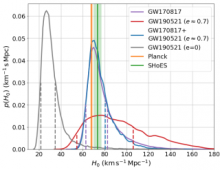
Abstract
Gravitational wave observations can be used to accurately measure the Hubble constant H0 and could help understand the present discrepancy between constraints from Type Ia supernovae and the cosmic microwave background. Neutron star mergers are primarily used for this purpose as their electromagnetic emission can be used to greatly reduce measurement uncertainties. Here we estimate H0 using the recently observed black hole merger GW190521 and its candidate electromagnetic counterpart found by ZTF using a highly eccentric explanation of the properties of GW190521. We find that the reconstructed distance of GW190521 and the redshift of the candidate host galaxy are more consistent with standard cosmology for our eccentric model than if we reconstruct the source parameters assuming no eccentricity. We obtain H0=88.6+17.1−34.3\,km\,s−1Mpc−1 for GW190521, and H0=73.4+6.9−10.7\,km\,s−1Mpc−1 in combination with the results of the neutron star merger GW170817. Our results indicate that future H0 computations using black hole mergers will need to account for possible eccentricity. For extreme cases, the orbital velocity of binaries in AGN disks can represent a significant systematic uncertainty.